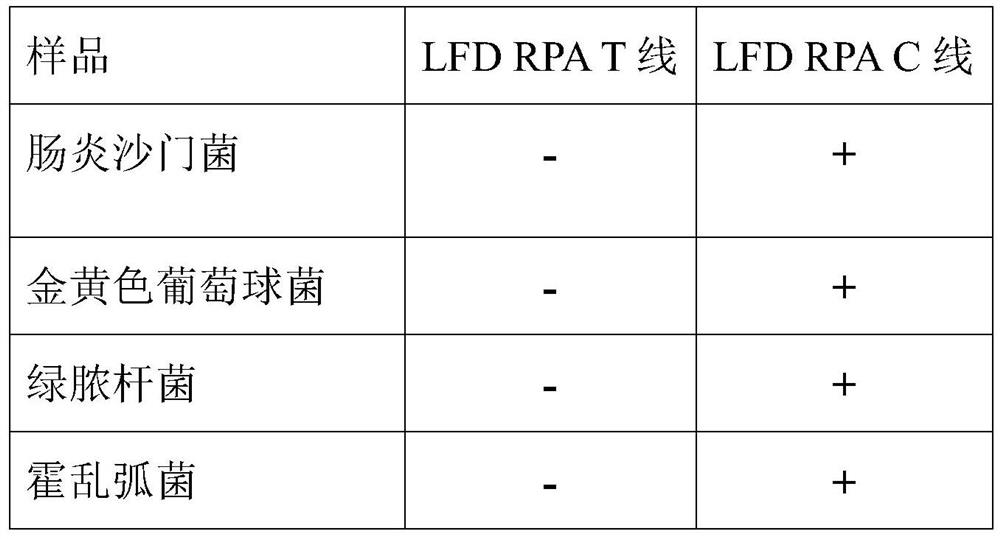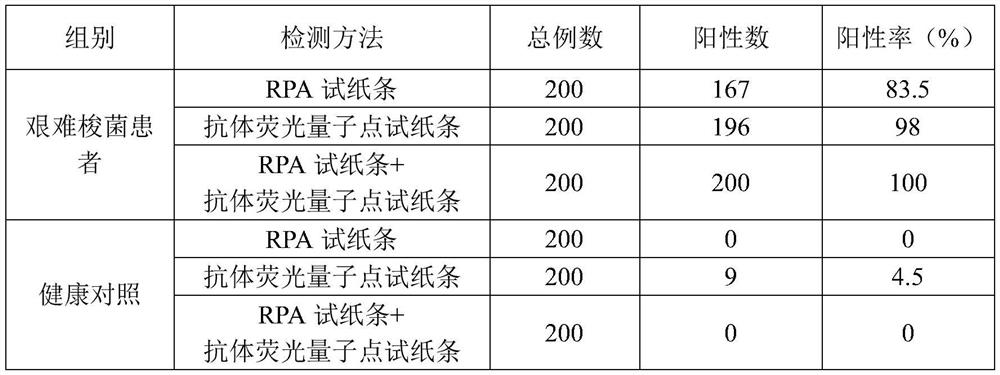A rapid inflammation detection kit
A kit and a specific technology, applied in the direction of biological testing, measuring devices, material inspection products, etc., can solve the problems of expensive testing, long time-consuming, long cycle, etc., and achieve the benefits of treatment, accuracy improvement, and early diagnosis Effect
- Summary
- Abstract
- Description
- Claims
- Application Information
AI Technical Summary
Problems solved by technology
Method used
Image
Examples
Embodiment 1
[0037] Example 1. Preparation of Clostridium difficile GDH antigen
[0038] After the Clostridium difficile C.difficile-630 strain was amplified and cultured, the DNA was extracted using a DNA extraction kit (Tiangen). Using the whole genome of the bacterial liquid as a template, the GDH gene was amplified by PCR and connected to the prokaryotic expression vector pET-30a. This expression vector was named "pET-30a-GDH". Transform the competent cells with the recombinant expression plasmid pET-30a-GDH, and after culturing for 12-14 hours, pick the positive single bacteria, put them in 2 mL / tube of LB (kana+) liquid medium, and shake the bacteria overnight at 180r at 37°C. The next day, mix the bacterial solution and LB freezing solution 1:1, use it as seed bacteria, and store it at -80°C for later use. Take 500 μl of seed bacteria, and expand the culture after recovery. After shaking the bacteria for about 4 hours, wait until it enters the logarithmic growth phase, and the OD60...
Embodiment 2
[0039] Example 2. Preparation of biotinylated Clostridium difficile GDH antigen
[0040] According to the instructions, the GDH antigen was biotinylated using biotinylated ligase B0101A (GnenCopoia). The biotinylated GDH antigen was named Biotin-GDH. Add BufferA / B and BirA ligase to the GDH antigen, and incubate at 30°C for 2h. The biotinylation efficiency was detected by ELISA method. The Biotin-GDH with an initial concentration of 500ng / ml was diluted 1:2 times, and coated with ELISA plates, followed by incubation with SA-HRP. Using the biotinylation standard as a control, the biotinylation labeling efficiency of Biotin-GDH was finally determined to be 75%.
Embodiment 3
[0041] Example 3. Preparation of anti-clostridium difficile GDH antibody
[0042] The recombinant protein GDH purified in Example 1 was used as an antigen to immunize Balb / c female mice. The recombinant protein was mixed with Freund's adjuvant in equal volume (1mL: 1mL), fully emulsified by syringe method, and immunized mice by abdominal multi-point injection method, and the immunization dose was 60μg / mouse. For the second and third immunizations, the mice were immunized with the same volume of Freund's incomplete adjuvant and recombinant protein GDH, and the mice were immunized by multi-point injection in the abdomen. The immunization dose was 30 μg / mouse. Seven days after the third booster immunization, the mouse serum was taken to detect the titer, and the mouse with the highest titer was immunized by tail vein injection, and the antigen was mixed with normal saline, and the dose was 50 μg / mouse. The splenocytes of the immunized Balb / c mice were taken and fused with the my...
PUM
| Property | Measurement | Unit |
|---|---|---|
| affinity | aaaaa | aaaaa |
Abstract
Description
Claims
Application Information
 Login to View More
Login to View More - R&D
- Intellectual Property
- Life Sciences
- Materials
- Tech Scout
- Unparalleled Data Quality
- Higher Quality Content
- 60% Fewer Hallucinations
Browse by: Latest US Patents, China's latest patents, Technical Efficacy Thesaurus, Application Domain, Technology Topic, Popular Technical Reports.
© 2025 PatSnap. All rights reserved.Legal|Privacy policy|Modern Slavery Act Transparency Statement|Sitemap|About US| Contact US: help@patsnap.com



